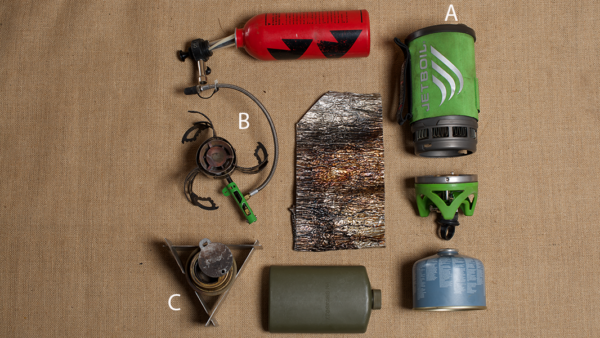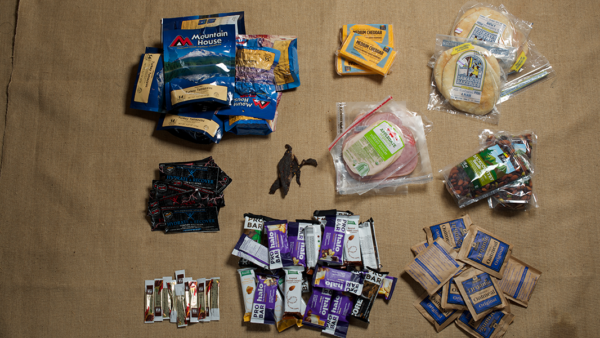
My dad always liked that old Napoleon quote about how an army marches on its stomach. During hunting season, he kept a plastic milk crate full of assorted goodies, jarred venison, corned meat, dried fruit, jerky, coffee nips, crackers, and toffee peanuts in the back of his Jeep Cherokee so that he could keep me and my brothers’ spirits up when we might otherwise have turned tired and whiny.
For sure, he and Napoleon understood something elemental about humans: we are better able to endure hardship when we’re well fed. This is especially true on rugged backcountry hunts, where it can be nearly impossible to eat enough food to make up for what you’re losing through climbing, walking, and staying warm.
Packing the appropriate cooking equipment and food for a backcountry hunt doesn’t need to be hard or expensive. Just follow these guidelines for a happy, well-fed hunt.
Stoves
There are several lightweight stoves that can serve the needs of backcountry hunters. Each has its ups and downs.
A: Jetboil
A great option for hunts when you’re using freeze-dried or dehydrated food.
Pros: Highly efficient; simple design; easy to use and maintain.
Cons: Poorly suited for anything besides boiling water; functions poorly in extreme cold; you can’t fly with the canisters, so they need to be purchased on location; you’re stuck with empty steel canisters that need to be packed out and then thrown away.
B: Optimus Nova
This is your all-around best option for camp cooking, as it is suitable for everything from making coffee to sautéed wild mushrooms to rendered black bear oil. White gas is the most appropriate fuel, but you can use regular gasoline or even diesel in a pinch.
Pros: variable flame; reliable in extreme cold and at high elevations; easy to find fuel.
Cons: loud, tricky to maintain and operate.
C: Liberty Mountain Westwind Alcohol Stove
These stoves burn denatured alcohol, are the bargain hunter’s best friend. These stoves are great for car camping and overnight backpacking trips, but they are inefficient; carrying enough fuel for an extended backcountry trip is a hassle.
Pros: extremely lightweight; virtually indestructible; maintenance free.
Cons: takes a long time to boil water; inefficient.
Cookware
The best cooking sets are made of stainless steel, anodized aluminum, or titanium. All are good, but titanium is best. Avoid plastic handles or lids, as you can’t use these over a fire. Also avoid non-stick surfaces, because they don’t last. A standard basic mess kit should include the following, in order of importance:
A: Small mug/pot with frying pan lid. This alone will cover your cooking/eating needs. Performs as a cooking pot, a bowl, a mug, and a fry pan. Works on a stove or over a fire.
B: Larger cooking pot. Handy for small groups, when you want to boil enough water for three or four folks to use at once. Also nice for more elaborate cooking projects like stews made from freshly killed meat.
C: Spork. No explanation needed, though if you eat a lot of freeze-dried food from bags, consider the longer-handled options.
D: Oil and seasoning. Use these for cooking camp meat, wild mushrooms, and whatever unexpected foodstuffs you happen to run into.
E: Portable Backpacking Grill. A luxury, but certainly convenient when you’re doing a lot of cooking over a campfire.
Backcountry Menu
This is a very simple menu for backcountry trips that can be shifted or supplemented in a multitude of ways.
Breakfast
Instant coffee packets: 2 per person per day.
Instant Oatmeal packets: 2 per person per day.
Lunch
Flatbread: Either tortillas, pitas, bagels-something that resists crumbling and will last for up to a week in a pack.
Hard cheese: 4 oz per person per day.
Lunch Meat: Either wild game salami or other cured wild game, or highly preserved packets of lunch meat; 4 oz per person per day.
Mustard, It’s worth it: A small bottle for a trip.
Dinner
Mountain House freeze dried meals: Buy the 2-serving bags. Each 2-serving bag is a dinner for one person. Pack several extra bags per person for emergencies. The shelf-life is 30 years, so don’t worry about waste if you don’t use them.
Small bottle of hot sauce.
Snacks, Desserts, Extras
Drink Mix Pouches: 2 per person per day.
Protein / Energy Bars: 5 per person per day.
Assorted High Energy Snacks: Jerky, nuts, candy bars, hard candy, granola, etc.
Pack according to expectations, but keep in mind that you will eat more of this stuff than you think.







